The crabapple tree is beyond beautiful. The leaves, the fruit, and the flowers all look worthy of a painting and they smell good too!
In our how to grow and care guide, we’ll look at some of the varieties of the crabapple tree, how to propagate from cuttings and seed, care guidelines for everything from sunlight to water, and some frequently asked questions. We also have a section on pests and diseases.
More...
Family: | Rosaceae |
|---|---|
Common Names: | Crabapple tree, Wild apple, European apple |
Location: | Outdoor |
Type: | Tree |
Growth: | Up to 6 metres tall and wide |
Sun requirements: | Full sun |
Foliage Colour: | Green, purple, red, bronze |
Flower Colour: | White, pink, magenta, red |
Flowering: | Mid to late spring |
Fruit: | Red but can also be golden, maroon or orange |
Maintenance level: | Average |
Poisonous for pets: | Yes, if seeds and core are consumed in large quantities |
Introducing the Crabapple tree
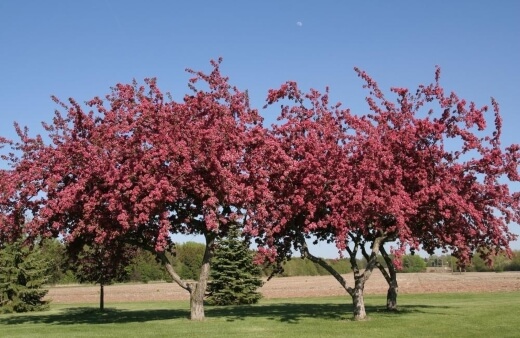
The crabapple tree is a real treat for the garden. The flowers are outstanding, but the leaves and fruit are also a gorgeous sight and tend to hang around until winter time.
No matter how much space you have in your garden, you’ll probably find a variety and cultivar that works for you. There are literally hundreds available but of course you want to choose those who will offer the best flowers, stunning leaves in autumn, and good looking fruit.
Crabapple is a hardy tree and the flowers are shades of white, pink and red. The apples might be green or gold or pink. You could use them to make a jam, or simply fill a bowl with them as décor.
The leaves are anything from red and yellow, to orange and purple. Crabapple is a tree that will grow in most climates, just not anywhere tropical.
Different Crabapples to Choose From
Malus ioensis ‘Plena’ | 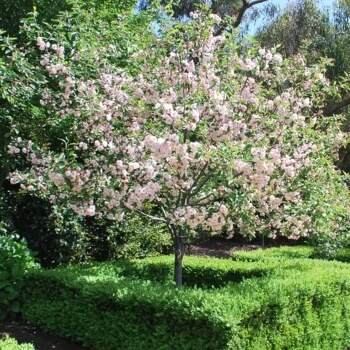 Source: warners.com.au |
Malus ioensis ‘Rubra’ |  Source: gardenexpress.com.au |
Malus floribunda | 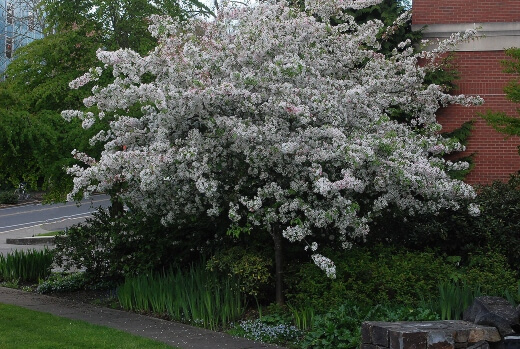 Source: landscapeplants.oregonstate.edu |
Malus spectabilis ‘Plena’ (Chinese Crabapple)Also called as the Chinese Crabapple, is a smaller tree and has double flowers that are pink and white. Like the Japanese Crabapple, it produces quite a spectacular display of flowers. |  Source: gardensonline.com.au |
Malus baccata | 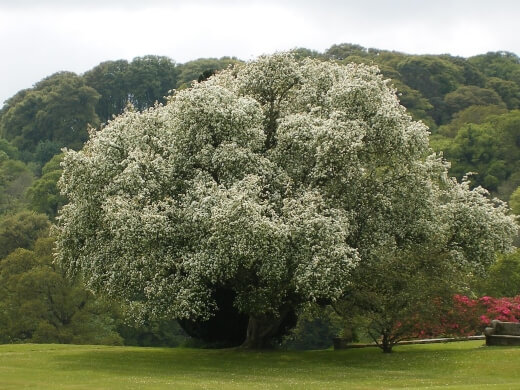 Source: treesandshrubsonline.org |
Malus trilobata | 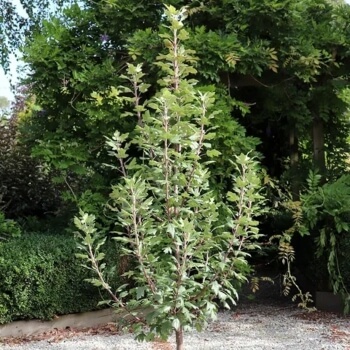 Source: warners.com.au |
Malus tschonoskii | 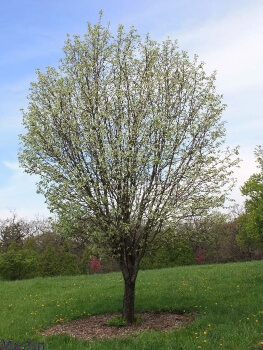 Source: cirrusimage.com |
Malus ioensis ‘Plena’ (Bechtel's Flowering Crabapple)

Source: warners.com.au
Also known as Bechtel's Flowering Crabapple, grows between 3 and 6 metres tall and wide. It produces flowers that are shades of white to pink.
Malus ioensis ‘Rubra’ (Red Flowering Crabapple)

Source: gardenexpress.com.au
Also known as the Red Flowering Crabapple, has red flowers that become pink as they mature. The leaves are dark green but have a copper tinge to them.
Malus floribunda (Japanese Crabapple)

Source: landscapeplants.oregonstate.edu
Commonly known as the Japanese Crabapple, has beautiful pink and delightful smelling flowers, with orange fruit. This is probably the most popular choice for a garden. In terms of size, it’s usually around 4 metres tall by 3 metres wide.
Malus spectabilis ‘Plena’ (Chinese Crabapple)

Source: gardensonline.com.au
Also called as the Chinese Crabapple, is a smaller tree and has double flowers that are pink and white. Like the Japanese Crabapple, it produces quite a spectacular display of flowers.


Get Your Free Guide:
Master Growing Australian Natives eBook
A Must Have Complete Guide for Every Australian Garden
Get Your Free Guide:
Master Growing Australian Natives eBook
A Must Have Complete Guide for Every Australian Garden
Malus baccata (Siberian Crabapple)

Source: treesandshrubsonline.org
Commonly called as Siberian Crabapple, can reach up to 6 metres in height and produces white flowers with red or yellow fruit.
Malus trilobata (Lebanese wild apple)

Source: warners.com.au
Commonly known as the Lebanese wild apple, is a narrow tree with leaves that look very similar to a maple tree. It produces big white flowers and green fruit.
Malus tschonoskii (Flowering Crab)

Source: cirrusimage.com
Also called as the Flowering Crab, has leaves that are more beautiful than the flowers or the fruit. They are narrow trees that tend to take on a pyramid shape.
How to Grow Crabapple Tree
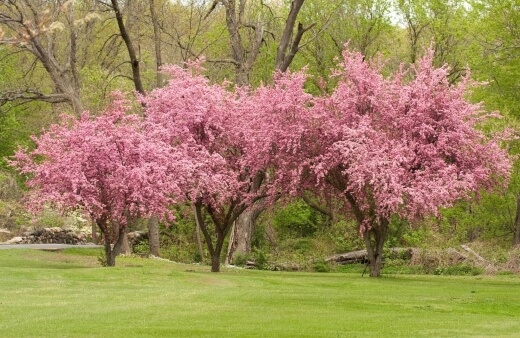
Crabapple Tree Propagation
How to Propagate Crabapple Tree from Cuttings
Once you’ve decided which container to use, you can fill it with peat and sand in the same amounts. You should first soak the peat in water and then mix it with the sand.
When taking your cutting, you’re aiming for a length between 12 and 18cm and it should have some new leaves on the tip of it. You can cut the stem half a centimetre below a group of leaves. Once you have the cutting in hand, you can pluck off any older leaves.
Dip your cut stem in rooting hormone and then pop it into your container so that the leaves that are lowest actually sit on the surface of the mixture. Press it down around the cutting.
Find an outdoor spot for the cutting that has shelter but still gets some light. You don’t want any wind or direct sun. You can sprinkle some water onto the mix and be sure to keep the mixture moist.
A good way to ensure enough moisture is a spray bottle with a misting about 3 times a day, including the underneath of the leaves.
Around the 6 week mark you can now start checking for roots. When you give the cutting a tug, does it feel quite firm in the growing mix? If yes, then you know you’ve got roots!
Your cutting can live outside in part shade for the rest of summer and in autumn you can transplant it.
See our in depth guide on the types of cutting and how to take them here.

Propagating Crabapple Tree from Seeds
Mix a couple of crabapple seeds with about three handfuls of compost and mix them well. The compost should be peat-free and you can also use something like leaf mould compost.
Add some water to wet the mix but be sure not to overdo it. If you feel like you’ve added too much water, just sprinkle in more compost.
Next you need to put the pot in a plastic bag and tie it closed. Pop the bag in the fridge for about 3 months. It can take up to 14 weeks for the seeds to sprout.
You might be wondering why you need to chill the seed mixture. This process actually helps the seeds germinate as the environment is cold and moist.
The fancy name for this process is stratification. From around 10 weeks, you can start checking your seeds often and if they’ve started to sprout you can then plant them.
Ideally, you should plant your crabapple tree in spring or autumn. This is our recommendation because generally during these seasons you would have moist soil and the temperature is cooler.
When you are ready to plant, you can dig a hole that’s twice the width and depth of the root ball and when you place it in the ground, the top of the root ball should stick out a bit above the ground. You can add compost to the soil and then give plenty of water.
How to Care for Crabapple Tree
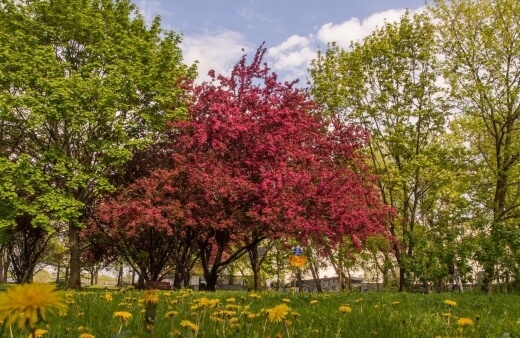
Sunlight Preference
Your crabapple tree is a lover of full sun so choose an appropriate spot. These trees like a climate with a mild summer and a cold winter.
Best Soil to Use
The crabapple tree can handle most soil conditions. Just be sure to provide a well-draining soil. These trees also need enough air circulation to limit diseases.
Watering Schedule
Your crabapple tree will need some extra water during the first year once planted especially if the weather is hot and dry. When the tree is established, you can then stick to watering only when the weather is dry for long periods of time.
Adding mulch around the base of your tree helps keep moisture locked in as well.
Crabapple Tree Fertiliser
If your soil is quite fertile then your crabapple tree probably doesn’t need any fertiliser. Your tree will tell you if it needs more nutrients if it’s not producing enough flowers and fruit for example.
If you do a fertiliser top up, you can do this in spring with a slow-release fertiliser before you see any new growth on the tree.
Pruning Crabapple Tree
Your crabapple tree will need some beauty pruning every now and then to help keep it healthy and looking good. Aim to do your pruning late in winter or otherwise early in the springtime and as a rule, only cut off the branches that really need to go.
To help you with your pruning task, check out our review of the best pruning saws available in 2023.
Common Crabapple Tree Pests and Diseases
Apple scab
Apple scab is quite a common one and is caused by a fungus that attacks the leaves and the fruit. You’ll notice green or brown spots on the leaves. You can treat with a fungicide spray. Learn more about Apple scabs and how to deal with them here.
Cedar apple rust
This fungal disease forms red spots on the leaves and can attack the fruit as well. The damaged leaves mean that the tree will struggle to access sunlight and the nutrients that it needs.
In a really bad case, it can cause tree death. If you are dealing with an infected tree, there is no treatment and you’ll need to prune to limit the infection.
Remember to disinfect your tools between pruning cuts. You can also apply a fungicide to help contain the infection.
Fire blight
Fire blight is another one of those diseases that can’t be cured and you’ll need to try and limit the infection once again. The disease kills off flowers and new shoots and causes dieback in the branches.
You’ll see that the new shoots and leaves actually wilt and bend towards the ground – they start to look a bit like a hook. It makes the tree look like it’s battled a fire, hence the name.
An infected tree will need to be removed, and the good news is that the fire blight bacteria goes with it so you can start again with planting a new tree in the garden.
Powdery mildew
Powdery mildew is a common fungus and you’ll be able to spot it quite easily. It makes white powder like spots on the leaves but sometimes you’ll also see it on the stems or flowers.
These spots actually spread and can cover almost all the leaves. This fungus likes warm and dry conditions but also high humidity. If your tree doesn’t get enough sunlight and air circulation it’s the perfect breeding ground for powdery mildew.
The fungus won’t kill your tree but it can damage it and limit its water and nutrient intake. In some cases you’ll notice that the leaves become yellow or start to wither. There might be slower growth and less flowers too.
There are great organic fungicides that you can use for treatment. Anything that has sulphur, neem oil or potassium bicarbonate will be effective. Try and do this as soon as you notice the disease symptoms.
Neem oil for example is a great defence against lots of diseases. The oil creates an immune response that can help to fight off fungal, bacterial and viral infections.
Crabapple Tree Frequently Asked Questions
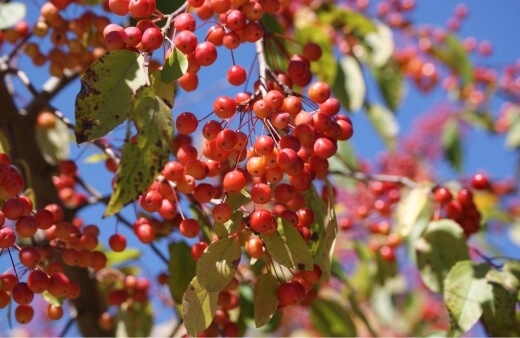
Are crabapple trees actually related to apple trees?
Yes they are in fact related and are both part of the Malus genus. They have lots of similarities but the main difference is the fruit. The crabapple fruit is smaller and more sour.
Can you eat the fruit from the crabapple tree?
You’re probably thinking about just picking an apple off the tree as you usually would, but taking a bite out of a crabapple will probably leave you pulling quite a strange face.
The taste of the crab apple is very tart so eating them fresh is not recommended. You can however use the fruit to make jam for example.
How do crabapple trees pollinate?
Crabapple trees don’t need another tree close by in order to pollinate. The tree flowers for a longer period than the traditional apple trees and this means much more pollen.
What’s amazing is that one crabapple tree can pollinate a whole lot of other apple trees in the area.
To enjoy more gardening tips and inspiration, sign up for our newsletter.
Wrapping Up Our Crabapple Tree Growing and Care Guide
If you’re keen to invest in a crabapple tree of your own, it will no doubt become a favourite spot in the garden, and be the inspiration for many photos. With many varieties to choose from, from more compact ones, to the taller varieties, any crabapple tree is a feast for the eyes.
They are not difficult to care for (or to propagate), so start planning your spot in the garden. We’re giving the lovely crabapple tree our green thumbs up.
Published on August 19, 2022 by Maisie Blevins
Last Updated on February 22, 2025




